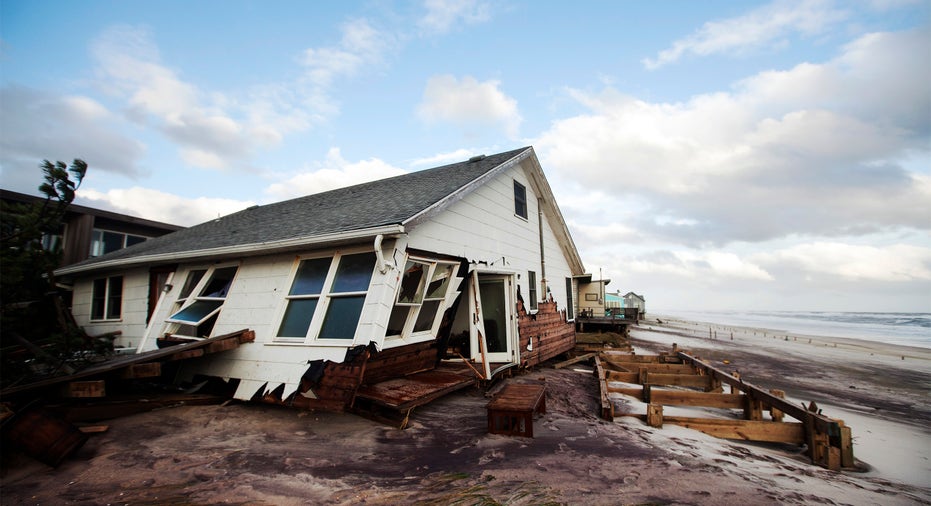Sandy Stirs Up Misleading Economic Arguments

Economists and analysts are now debating whether Hurricane Sandy will add to economic growth, comparing the aftermath to Hurricane Katrina. Be wary of misleading economic arguments.
Hurricane Sandy is different from Hurricane Katrina, in that it hit a broader part of the country, the most densely populated 500-mile stretch of the U.S., the northeastern seaboard, and is still moving inland.
The storm is striking an estimated 20% to 25% of the U.S. population. The states affected, now tolling at around two dozen plus Washington, D.C., deliver an estimated 15% to 20% of U.S. GDP.
Forty-three people are now dead due to the storm, millions of homes are without power, and the storm’s estimated economic losses continue to mount, to more than $50 billion.
The megastorm is akin to the 1938 “Long Island Express” hurricane that struck New York City and New England, helping to carve out the Hamptons and create the east end of Long Island as it exists today. Hurricane Sandy is certainly now redefining the New Jersey coastline, as well as parts of New York and Connecticut.
Hurricane Katrina does show that job growth could be temporarily hurt. When the hurricane struck New Orleans and the Gulf Coast in 2005, it temporarily dragged down job growth. The economy was creating about 200,000 jobs a month, government figures show. But that number dropped to 66,000 in September 2005 and 80,000 in October 2005, analysts note. Jobs then rebounded that November, to 334,000, analysts note.
However, some economists are now saying the aftermath of Superstorm Sandy will give a much-heeded boost to economic growth. Under that argument, sales lost because of store closures will probably be made up in extra shopping later in the week, or economic growth in rebuilding.
Hurricane Sandy, though, is a broad-based consumer demand and business story, one with a potentially significant impact on GDP, and one that raises again the Broken Window Fallacy provided by Frederic Bastiat 162 years ago.
Bastiat argued that any effort to rebuild and spend after a disaster either offsets other economic activity, pulls in economic activity from other quarters or, in the case of a hurricane, other geographic areas.
The fallacy being, the U.S. shouldn’t spend taxpayer money to then destroy and rebuild. If that were true, then the U.S. should hire government workers to dig holes and refill them (with spoons to create even more jobs, economist Milton Friedman joked).
The problem with this “spend money to create money” argument, or as Vice President Joe Biden has said, “spend money to keep from going bankrupt,” is that taxpayers foot the bill for government spending in a free market that the government then counts in GDP, with little regard to whether government spending created any value at all.
Yes, the cleanup will count in GDP, but that doesn’t mean the U.S. will have become richer as a country.
Too often ignored is the loss in capital value of the assets sitting there before they were destroyed by the storm—and the economic activity those assets create. Ignored, too, is the fact that GDP is more like a cash flow statement, not an asset and liability statement.
And so, JPMorgan Chase (NYSE:JPM) analysts have estimated a $36 billion boost to housing and construction from Sandy.
But that money doesn’t come from thin air, it comes from somewhere, consumer pockets, as consumers spend to rebuild.
Meaning, Hurricane Sandy will likely hit retail sales, meaning a less optimistic holiday shopping season (where some 40% of retail sales are made).
It also could cause weaker car sales and housing starts, says RealTime Economics.
The Northeast delivers about a fifth of total U.S car sales and 10% of housing starts, estimates show. Economists and analysts at places like Societe Generale and IHS Global Insight are forecasting a drag on an already weak economy in coming weeks.
It could cause a temporary spike in jobless claims as well as, of course, government jobs and aid from places like FEMA, an outgrowth of a program launched under the Nixon Administration and boosted by ensuing presidents Jimmy Carter, Ronald Reagan, George H.W. Bush and George W. Bush.
However, worth noting is that taxpayers in New Jersey paid $14,900 per capita in total federal taxes, and got back $7,400 in federal government spending, making the state a net contributor to the federal government of $7,500 per capita, based on federal 2007 data that covers all federal taxes and outlays.
The state is ranked third among the biggest net payers into the federal government, the data show.
Delaware is first, with a net per capita contribution to the government of $12,300, Connecticut is fourth at $6,200 per capita, and New York is fifth at $4,500 per capita paid in to the federal government.



















